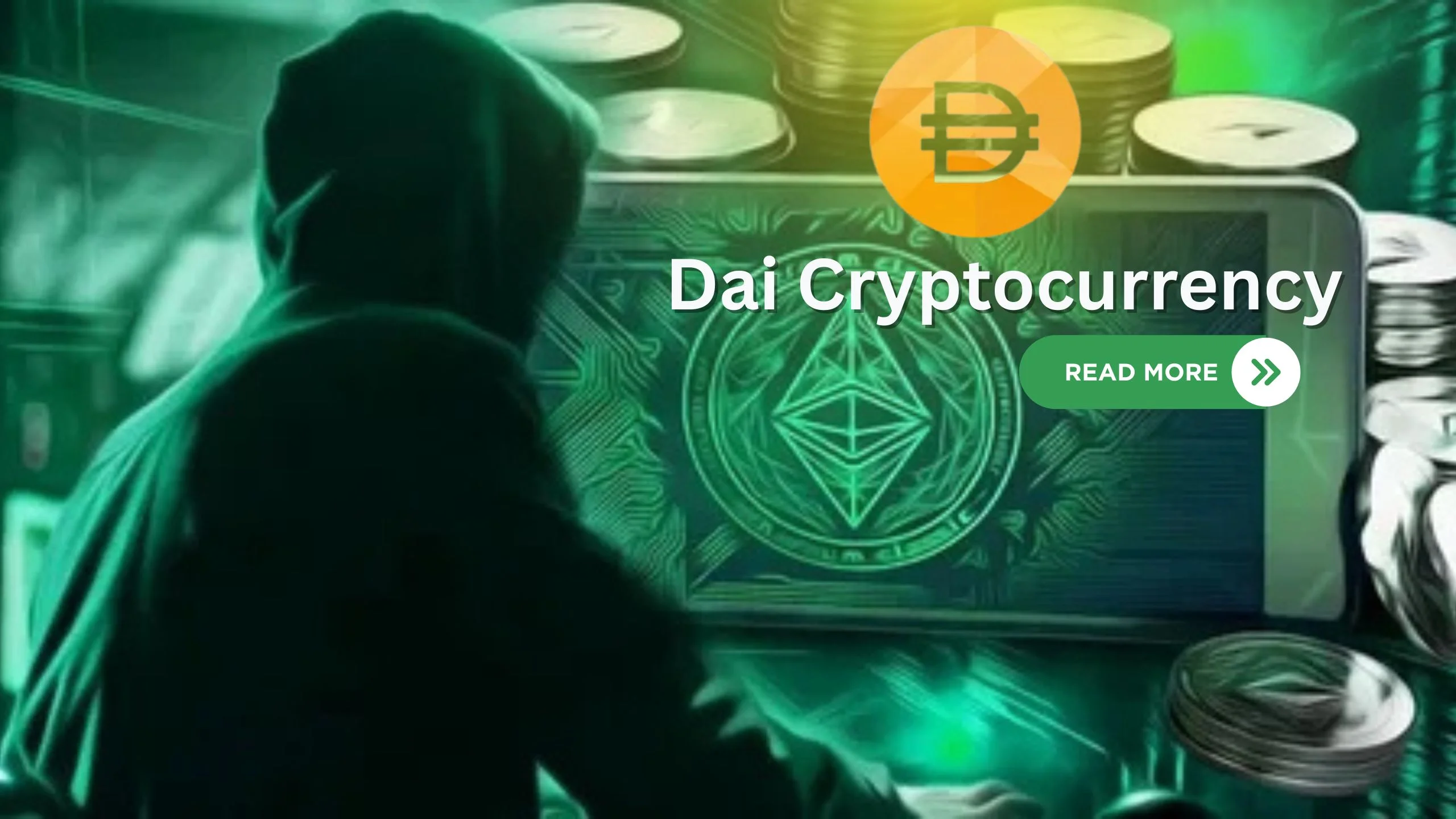Dai is a decentralized, crypto-backed stablecoin that stays close to $1 USD using smart contracts and MakerDAO governance.
In the ever-evolving world of decentralized finance (DeFi), stablecoins like Dai have emerged as critical assets. Unlike highly volatile cryptocurrencies such as Bitcoin or Ethereum, Dai offers stability while retaining the key benefits of blockchain technology: decentralization, transparency, and accessibility.
This editorial guide breaks down everything you need to know about Dai — from what it is, how it works, why it matters, and how you can use it.
What is Dai?
Dai is a decentralized, crypto-collateralized stablecoin that aims to maintain a 1:1 peg with the U.S. Dollar (USD). Unlike centralized stablecoins (like USDT or USDC), Dai is governed by smart contracts and managed by the MakerDAO community.
✅ Key Facts:
- Ticker Symbol: DAI
- Blockchain: Primarily runs on Ethereum (ERC-20 token)
- Stability Mechanism: Over-collateralized loans
- Governance: MakerDAO decentralized autonomous organization (DAO)
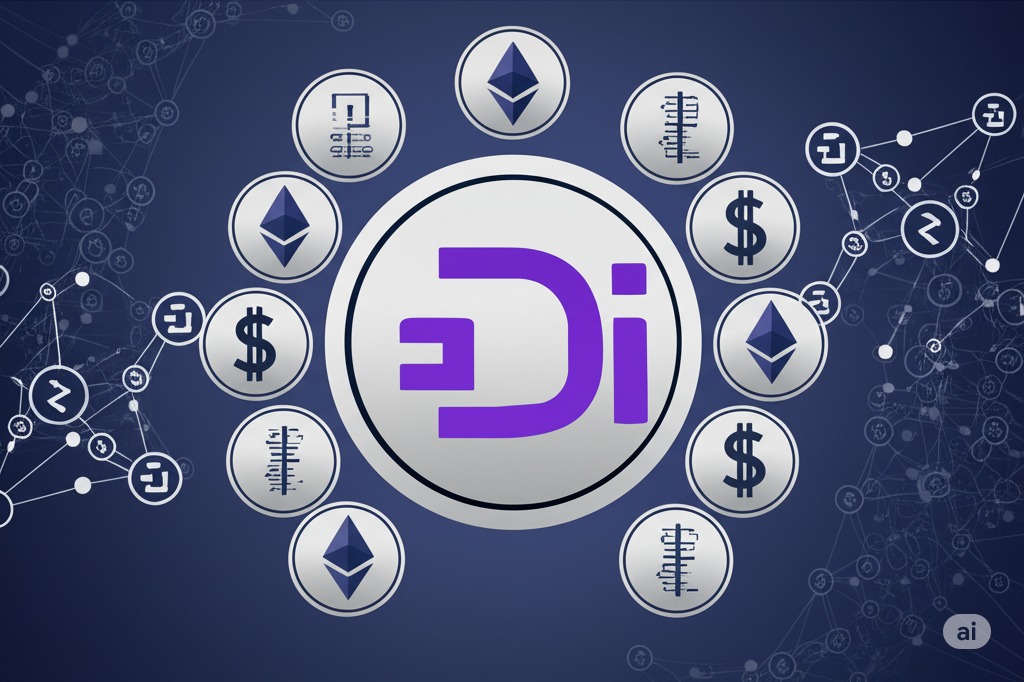
How Does Dai Work?
Dai’s unique stability is maintained through an innovative system of collateralized debt positions (CDPs), now called Vaults, on the Maker Protocol.
🛠️ Mechanism in Action:
- Collateralization:
- Users lock up crypto assets (e.g., ETH) as collateral in Maker Vaults.
- Minting Dai:
- The locked collateral enables users to mint Dai tokens, which are then used as a stable store of value or medium of exchange.
- Stability Fee:
- Users pay a fee (interest) when they repay and withdraw their collateral.
- Peg Maintenance:
- The system uses incentives and penalties to keep Dai’s price stable around $1.
History and Background of Dai
| Year | Milestone |
|---|---|
| 2015 | MakerDAO project founded by Rune Christensen |
| 2017 | Original Single Collateral Dai (Sai) launched |
| 2019 | Multi-Collateral Dai (MCD) launched, replacing Sai |
| 2021+ | Rapid adoption in DeFi apps and liquidity pools |
Dai’s architecture has proven resilient even during significant market volatility.
Key Features of Dai
🔑 Highlights:
- Decentralized: No single entity controls Dai.
- Collateral-backed: Users must deposit more collateral than the Dai they mint.
- Transparent: Smart contracts and governance votes are public.
- Programmable: Integrates seamlessly with DeFi protocols.
- Borderless: Accessible to anyone with an internet connection and crypto wallet.
Benefits of Using Dai
Why do crypto traders, investors, and DeFi enthusiasts use Dai?
🌟 Advantages:
- Stability in Volatile Markets: Hedge against crypto price swings.
- Financial Inclusion: No traditional banking required.
- DeFi Yield Opportunities: Earn interest by lending Dai on platforms like Aave or Compound.
- Low Transaction Costs: Send stable value globally for a fraction of traditional wire fees.
- Transparency: Open-source and auditable.
Risks and Challenges
While Dai offers clear benefits, it’s not without risk:
- Over-Collateralization Risk: Falling crypto prices can trigger liquidations.
- Smart Contract Bugs: Bugs could lead to vulnerabilities.
- Peg Deviations: Extreme market conditions could temporarily break the peg.
- Governance Attacks: Voter apathy or malicious voting in MakerDAO could impact stability.
👉 Always conduct due diligence and use reputable wallets and protocols when interacting with Dai.
📈 Dai (DAI) Price Prediction 2020 to 2030
Unlike most cryptocurrencies, Dai is designed to maintain a stable value — always aiming to be worth around $1 USD. However, minor fluctuations do occur due to market dynamics, supply and demand, and the collateralization system behind Dai. Let’s break down Dai’s historical stability, current outlook, and what experts anticipate for its future.
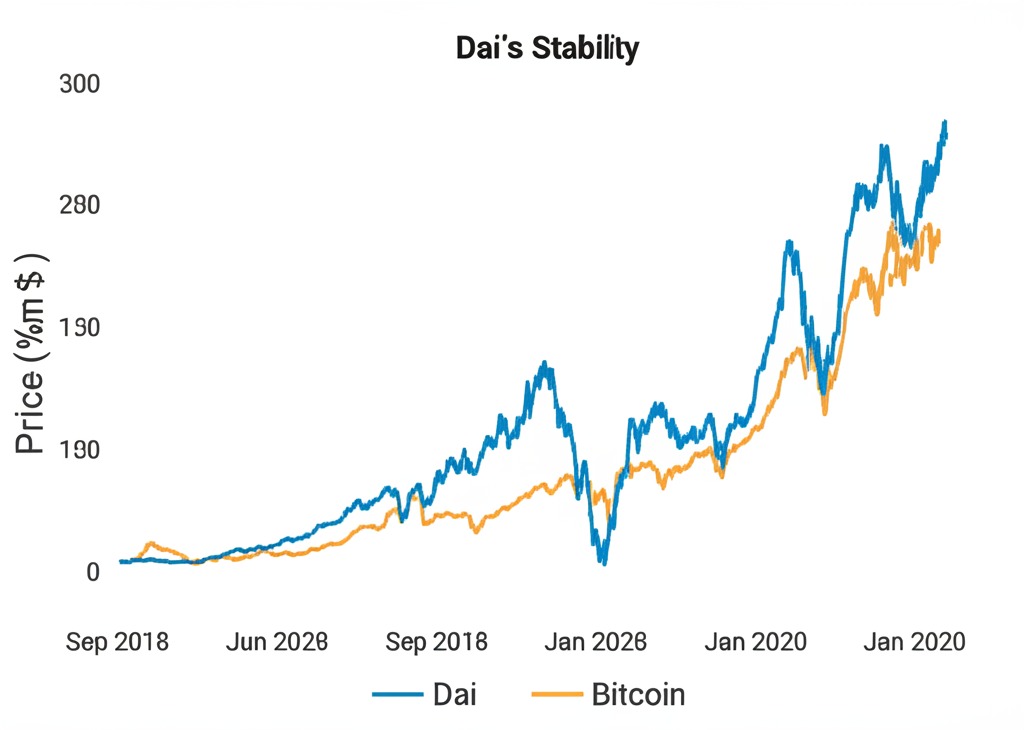
✅ Dai Price History
2020 — 2022:
- Throughout 2020, Dai successfully maintained its $1 peg even during market chaos like the COVID-19 crash and the DeFi boom.
- In 2021, during the crypto bull run, usage of Dai surged. Its market cap grew as DeFi lending, yield farming, and liquidity pools took off.
- Minor de-pegs occurred during extreme volatility (e.g., March 2020’s “Black Thursday”), but the MakerDAO system rebalanced quickly.
Key Historical Average:
- Average Price: $0.99 – $1.01 USD
- All-Time High/Low: Around $1.03 / $0.97 during extreme volatility.
📅 Dai Price in the Present (2024–2025)
In 2024 and mid-2025, Dai remains one of the most trusted decentralized stablecoins. With the growth of Layer 2 networks (like Arbitrum, Optimism) and multi-chain bridges, Dai’s use cases have expanded, keeping demand steady.
- Current Price: ~$1.00 USD
- Market Cap: Continues to grow steadily, hovering in the billions.
- Adoption: More merchants, remittance apps, and DeFi projects integrate Dai, strengthening its ecosystem.
✅ Stability Factors:
MakerDAO governance upgrades, improved collateral management, and increased transparency help maintain Dai’s peg.
🔮 Dai Price Forecast (2025–2030)
Unlike speculative crypto coins, stablecoins don’t have moonshot price targets. Instead, the main prediction focuses on how well Dai can maintain its peg and expand its real-world usage.
| Year | Forecasted Average Price | Key Factors |
|---|---|---|
| 2025 | $1.00 USD | Strong DeFi growth, stable governance |
| 2026 | $1.00 USD | Possible integration with CBDCs |
| 2027 | $1.00 USD | More remittance and merchant adoption |
| 2028 | $1.00 USD | Improved multi-chain interoperability |
| 2029 | $1.00 USD | Growth in developing markets |
| 2030 | $1.00 USD | Regulatory clarity boosts trust |
Potential Risks:
- Smart contract vulnerabilities
- Sudden crypto market crashes affecting collateral
- Regulatory pressures on DeFi
🏆 Expert Outlook: Will Dai Remain Stable?
Most crypto analysts believe Dai will keep its stable value as long as MakerDAO’s system remains overcollateralized and governance stays strong. Unlike algorithmic stablecoins that have failed (like TerraUST), Dai has proven its resilience for nearly a decade.
⚡ Bottom Line: Dai’s Future Value
- Short-Term: Expect Dai to remain within a tight $0.99–$1.01 range.
- Long-Term: The peg should hold if governance, collateral, and DeFi adoption continue to evolve responsibly.
- Opportunities: For investors, Dai’s real value lies in earning passive income through lending, staking, or using it as a reliable hedge during crypto market swings.
🔍 Key Takeaway
Dai won’t make you rich overnight by price appreciation, but it can protect your wealth and unlock new financial opportunities in the decentralized economy.
How to Buy and Store Dai
Getting started with Dai is simple if you follow these steps:
🛒 Where to Buy Dai:
- Centralized Exchanges: Binance, Coinbase, Kraken.
- Decentralized Exchanges (DEXs): Uniswap, Sushiswap, 1inch.
🔒 How to Store Dai:
- Hot Wallets: MetaMask, Trust Wallet.
- Hardware Wallets: Ledger, Trezor (highest security).
- DeFi Platforms: Stake or lend your Dai for additional yield.
✅ Tip: Always double-check smart contract addresses before transactions.
Use Cases of Dai in DeFi
Dai is an integral part of the DeFi ecosystem. Some popular use cases include:
📈 Popular Use Cases:
- Savings: Deposit Dai into DeFi protocols to earn yield.
- Liquidity Pools: Provide liquidity on DEXs and earn trading fees.
- Collateral for Loans: Use Dai as collateral to borrow other crypto.
- Remittances: Send stable value across borders.
- E-commerce: Some merchants accept Dai for goods/services.
Dai vs Other Stablecoins
How does Dai stack up compared to other popular stablecoins? Here’s a quick comparison:
| Feature | Dai | USDT (Tether) | USDC (USD Coin) |
|---|---|---|---|
| Type | Decentralized | Centralized | Centralized |
| Backed By | Crypto Collateral | Fiat Reserves | Fiat Reserves |
| Governance | MakerDAO | Tether Ltd. | Circle + Coinbase |
| Transparency | Fully transparent | Limited audits | Regular audits |
| Popular Uses | DeFi | Trading pairs | DeFi, payments |
Future of Dai
As the DeFi space grows, Dai is expected to remain a key player:
✅ Emerging Trends:
- Multi-chain Expansion: Bridging Dai to other blockchains (Polygon, Arbitrum).
- Enhanced Governance: Ongoing proposals to improve peg stability.
- Integration with CBDCs: Potential interoperability with national digital currencies.
- Increased Adoption: More merchants and services accepting Dai as payment.
🔍 Lesser-Known Facts & Trends About Dai
✅ 1. Real-World Asset (RWA) Backing:
- MakerDAO has been exploring adding real-world assets (like U.S. Treasury bonds or tokenized real estate) as collateral to back Dai. This diversification could make Dai more resilient to crypto market volatility.
✅ 2. Dai Savings Rate (DSR):
- Holders can deposit Dai into the DSR smart contract and earn passive interest directly from MakerDAO’s protocol revenue. This rate adjusts based on governance votes and helps manage supply and demand for Dai.
✅ 3. Spark Protocol:
- In 2023–2024, MakerDAO launched Spark Protocol, a DeFi lending market that integrates directly with Dai, offering more efficient borrowing and lending — and it’s helping Dai compete with big players like Aave and Compound.
✅ 4. Endgame Plan:
- MakerDAO is planning a huge protocol redesign called Endgame, which will change governance structures and introduce “MetaDAOs” — subDAOs that can spin up new collateral assets and revenue streams for the Maker ecosystem, boosting Dai’s sustainability.
✅ 5. Multi-Chain Expansion:
- Dai is increasingly available on other blockchains, not just Ethereum — think Polygon, Arbitrum, Optimism, Avalanche, and even emerging Layer 1s. This multi-chain presence helps Dai stay relevant as DeFi goes cross-chain.
✅ 6. Growing Use in Remittances:
- In regions with unstable fiat currencies (Latin America, Africa), more people are using Dai to send or save money instead of volatile local currencies. Some startups integrate Dai into mobile money apps for cross-border payments.
✅ 7. Regulatory Preparedness:
- Compared to some stablecoins, Dai’s decentralized model gives it a strategic advantage against strict stablecoin regulations — since there’s no centralized issuer to shut down. MakerDAO governance continues to discuss how to stay compliant but decentralized.
✅ 8. Impact of Liquid Staking Collateral:
- Liquid staking tokens like stETH (staked ETH) are now used as collateral to mint Dai. This means people can earn ETH staking rewards while borrowing Dai — a win-win that could expand Dai’s collateral base.
✅ 9. Dai in E-Commerce:
- Some e-commerce merchants (particularly in crypto-friendly markets) now accept Dai as payment to avoid volatile crypto price swings and high credit card fees.
✅ 10. Future AI and DeFi Integration:
- Some think future DeFi protocols will use AI bots to help manage vault collateralization more efficiently, reducing the chance of sudden liquidations — which would strengthen Dai’s peg.
📊 Dai Market Adoption and Supply Growth (Historical + Forecast)
| Year | Estimated Dai Circulating Supply | Key Adoption Highlights |
|---|---|---|
| 2017 | ~5 million DAI | Original Single-Collateral Dai (Sai) launched — early DeFi experiments. |
| 2018 | ~20 million DAI | MakerDAO starts gaining traction; first wave of CDP users. |
| 2019 | ~50 million DAI | Multi-Collateral Dai (MCD) launched, replacing Sai. |
| 2020 | ~90 million DAI | DeFi Summer: surge in DeFi lending and liquidity pools. |
| 2021 | ~5 billion DAI | Massive growth: bull market + yield farming craze. |
| 2022 | ~6 billion DAI | Bear market hits, but Dai remains strong in stablecoin rankings. |
| 2023 | ~5.5 billion DAI | Adoption steady; Spark Protocol launched for lending/borrowing. |
| 2024 | ~6 billion DAI | Multi-chain expansion; more use in remittances and RWAs. |
| 2025 | ~7 billion DAI (forecast) | Wider real-world asset backing; new use cases in developing markets. |
| 2026 | ~8 billion DAI (forecast) | Integration with emerging Layer 2s and global e-commerce. |
| 2027 | ~9 billion DAI (forecast) | MakerDAO “Endgame” plan starts rolling out; MetaDAOs diversify collateral. |
| 2028 | ~10 billion DAI (forecast) | Cross-chain bridges increase Dai liquidity across ecosystems. |
| 2029 | ~11 billion DAI (forecast) | Stablecoin remittances gain share in regions with fiat instability. |
| 2030 | ~12 billion DAI (forecast) | Global stablecoin regulation provides clarity; institutional DeFi grows. |
✅ Key Takeaways
- Dai’s supply grows primarily based on demand for borrowing and DeFi yield opportunities.
- Adoption spikes during bullish markets but remains robust during downturns due to its stablecoin nature.
- Real-world asset (RWA) collateral and multi-chain adoption are the biggest growth drivers going forward.
- Regulatory clarity and integration with CBDCs could boost confidence in Dai’s decentralized model.
⚡ Bonus Tip
Watch the MakerDAO governance votes and collateral portfolio:
These are the strongest signals for whether Dai’s supply can keep growing sustainably without risking its peg.
If you’d like, I can also make a downloadable version of this table in CSV or PDF format for your site or email list — just say the word!
🔮 How MakerDAO’s Endgame Plan Might Impact Dai Holders
The MakerDAO Endgame Plan is one of the most ambitious governance and design overhauls ever proposed in the decentralized finance (DeFi) world. Launched by MakerDAO’s founder, Rune Christensen, the Endgame Plan aims to make the Maker Protocol more resilient, scalable, and adaptable for the future.
But what does this mean for everyday Dai holders like you?
Let’s break it down.
✅ What Is the MakerDAO Endgame Plan?
In simple terms, the Endgame Plan is a multi-year roadmap that restructures how MakerDAO works — covering governance, collateral strategies, revenue generation, and ecosystem expansion.
The plan includes:
- Launching MetaDAOs — sub-communities that focus on specific collateral types, markets, or initiatives.
- Increasing the use of real-world assets (RWAs) as collateral, like U.S. Treasuries or tokenized loans.
- Enhancing governance participation by rewarding MKR token holders more efficiently.
- Introducing protocol autonomy measures so the system can self-correct during stress events.
⚙️ 5 Ways the Endgame Plan Could Impact Dai Holders
1️⃣ Stronger Peg Stability
The biggest benefit for Dai holders is a more robust peg.
- The plan’s focus on diversified collateral — including real-world assets — helps reduce the risk that falling crypto prices alone could destabilize Dai.
- Improved risk models and automated governance responses will help keep Dai near $1 USD even during extreme market events.
👉 What this means for you: Your Dai remains reliable for saving, remittances, or payments.
2️⃣ Potential Yield Opportunities
The Endgame could bring more ways for Dai holders to earn passive income:
- More real-world asset collateral means MakerDAO generates more fees.
- These revenues could translate into better Dai Savings Rate (DSR) returns.
- MetaDAOs may offer unique yield or staking programs that indirectly benefit Dai holders.
👉 What this means for you: Your idle Dai could generate better returns compared to traditional bank savings.
3️⃣ Greater Decentralization and Resilience
By splitting MakerDAO into specialized MetaDAOs, governance becomes more modular and resilient to attacks or corruption.
- Better risk management means Dai’s collateral will stay strong.
- If one MetaDAO underperforms, it won’t drag down the whole system.
👉 What this means for you: Reduced systemic risk and more confidence in Dai’s future.
4️⃣ Global Expansion and Real-World Use Cases
The Endgame Plan strongly emphasizes expanding Dai’s real-world utility:
- More partnerships with payment processors, fintech apps, and emerging market remittance platforms.
- Localized MetaDAOs might tailor Dai adoption to different countries or regions.
👉 What this means for you: Dai could become even easier to use for everyday payments, cross-border transfers, or e-commerce.
5️⃣ Possible Regulatory Implications
As MakerDAO becomes more sophisticated and holds more RWAs, it may attract closer scrutiny from regulators.
- The Endgame design tries to keep Maker as decentralized as possible to avoid single points of failure.
- If successful, Dai could be more resilient to legal pressure than centralized stablecoins.
👉 What this means for you: Dai may remain available and censorship-resistant even in stricter regulatory environments.
⚡ Should Dai Holders Do Anything Now?
✅ Short Answer: Stay informed.
- Follow MakerDAO governance forums for major Endgame updates.
- Monitor any changes to the Dai Savings Rate (DSR).
- Watch how the collateral portfolio evolves, especially with RWAs.
Holding Dai remains low risk compared to other crypto assets, but understanding the governance behind it helps you stay ahead of any major changes.
📌 Final Thoughts: A Stronger Future for Dai?
If the Endgame Plan succeeds, it could set the standard for how decentralized stablecoins survive and thrive in an evolving global financial system.
For Dai holders, this means:
- More peg stability
- More ways to earn yield
- Greater resilience against market shocks and regulation
In a world where stablecoins are under increasing scrutiny, a robust and adaptive MakerDAO could make Dai one of the most trusted stablecoins in the market.
🗳️ Understanding MakerDAO Governance: Why It Matters for Dai’s Peg
MakerDAO is a decentralized autonomous organization (DAO) that manages the Maker Protocol, which governs Dai. Unlike centralized stablecoins (like USDT or USDC), Dai relies on smart contracts and community-driven votes to maintain its $1 peg.
Governance is handled by holders of the MKR token, who propose and vote on changes that affect:
- The types of collateral accepted
- Risk parameters and collateralization ratios
- The Dai Savings Rate (DSR)
- Stability fees (interest rates on loans)
- Emergency shutdown measures
- Adoption of new structural frameworks like the Endgame Plan
⚙️ Key Governance Proposals Affecting Dai’s Stability
Here’s a breakdown of the most important types of proposals that directly influence Dai’s peg, both now and in the next few years:
1️⃣ Collateral Onboarding & Offboarding Proposals
What they do:
- Decide which assets (crypto or real-world) can be used to mint Dai.
- Proposals add, remove, or adjust collateral types to maintain system health.
✅ Why it matters for Dai’s peg:
- More diversified collateral reduces reliance on any single volatile crypto.
- If risky assets are removed, it lowers the chance of under-collateralization during market crashes.
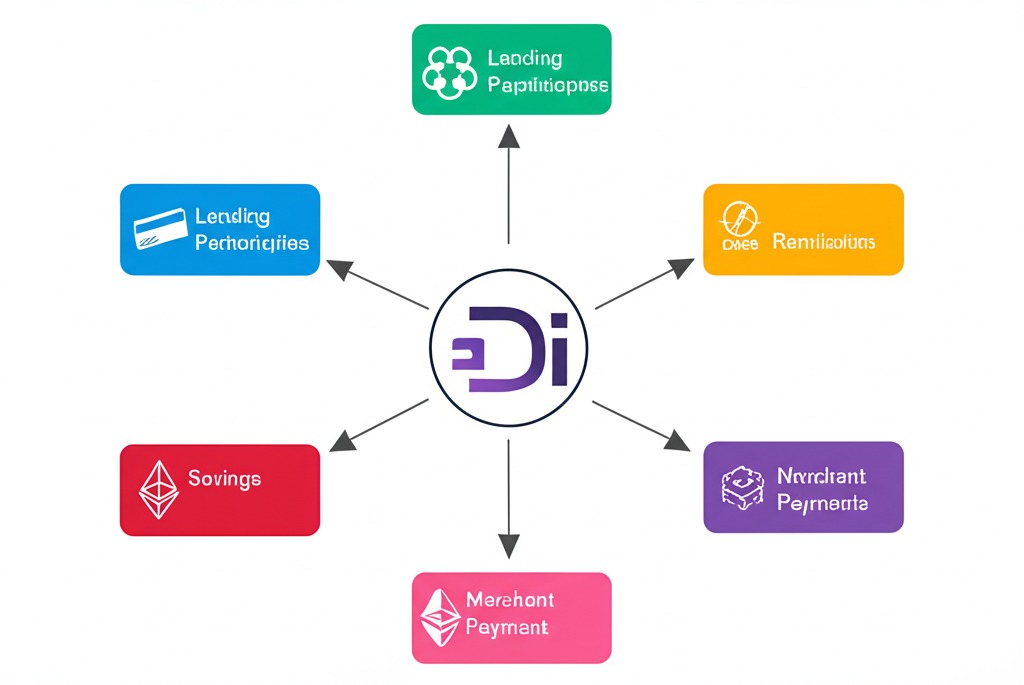
2️⃣ Collateralization Ratio Adjustments
What they do:
- Set the minimum over-collateralization required to mint Dai.
- For example, a Vault for ETH might require 150% collateralization.
✅ Why it matters:
- Higher ratios improve peg security but can limit Dai supply.
- Governance must balance supply and risk to keep Dai’s price stable.
3️⃣ Stability Fee Changes
What they do:
- Adjust the interest rate borrowers pay when they mint Dai.
✅ Why it matters:
- If Dai trades above $1, the fee may decrease to encourage borrowing and increase supply.
- If Dai trades below $1, the fee may increase to reduce supply.
This dynamic monetary policy is a big reason Dai’s peg stays tight.
4️⃣ Dai Savings Rate (DSR) Updates
What they do:
- Adjust the interest rate paid to Dai holders who deposit their coins in the DSR smart contract.
✅ Why it matters:
- A higher DSR incentivizes people to hold Dai, decreasing market supply and pushing the peg up if needed.
- A lower DSR can loosen supply if Dai is trading too high.
5️⃣ Real-World Asset (RWA) Collateral Proposals
What they do:
- Add assets like tokenized bonds, real estate, or invoices as collateral.
✅ Why it matters:
- RWAs provide less volatile, yield-generating collateral compared to crypto alone.
- This strengthens Dai’s peg because it spreads risk across traditional and digital assets.
Example: MakerDAO’s proposals to onboard U.S. Treasury-backed RWAs.
6️⃣ Emergency Shutdown Mechanisms
What they do:
- Activate a system-wide shutdown in extreme conditions.
- Users can redeem Dai for underlying collateral at its target value.
✅ Why it matters:
- Provides a last-resort method to ensure Dai maintains its value if the system is compromised.
- Protects Dai holders from catastrophic peg failure.
7️⃣ The Endgame Proposals
What they do:
- Implement a long-term redesign of MakerDAO governance.
- Includes splitting governance into specialized MetaDAOs.
- Aims to automate risk adjustments and collateral management.
✅ Why it matters:
- More flexible, autonomous governance means the protocol can react quickly to market shifts.
- This strengthens Dai’s peg by making the system more resilient and adaptable.
🔮 Why These Votes Matter for Dai Holders
As a Dai user or investor, you might not be voting directly — but understanding what’s being debated helps you:
- Assess if the system remains over-collateralized.
- Track how resilient Dai will be in a crypto downturn.
- Decide if lending or staking Dai remains low risk.
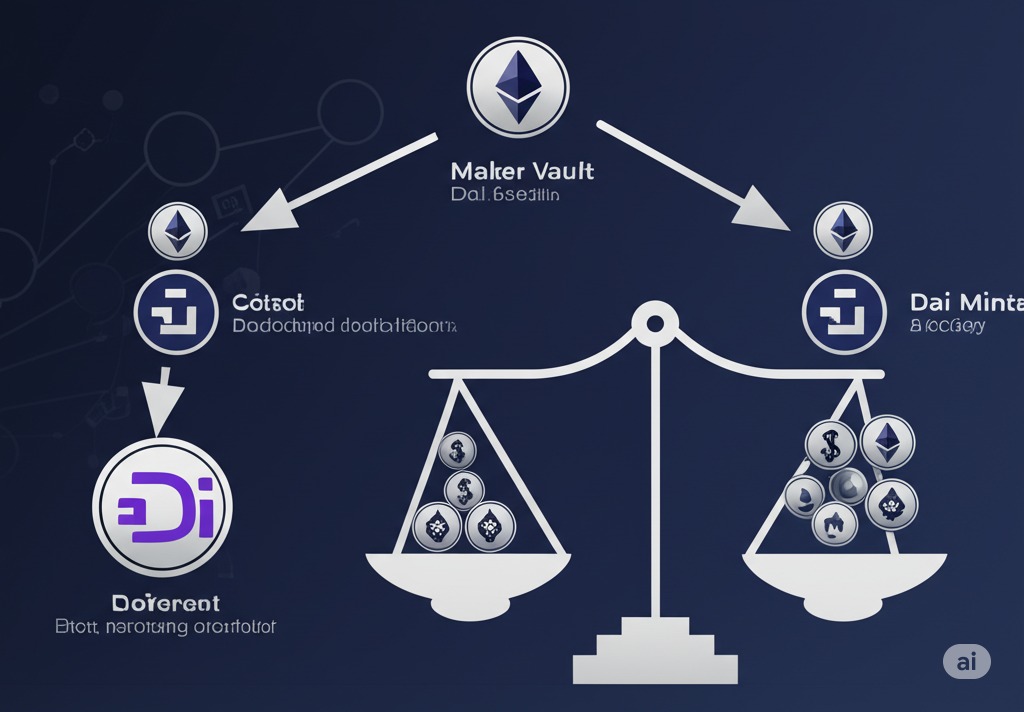
📌 How to Follow MakerDAO Governance
✅ Join the official MakerDAO Forum
✅ Track proposals and voting outcomes on Vote.MakerDAO.com
✅ Use tools like MakerBurn or Dune Analytics dashboards to watch:
- Dai’s market supply
- Collateralization ratios
- DSR trends
Frequently Asked Questions (FAQs)
🤔 Is Dai really stable?
Mostly, yes. Dai’s peg to $1 is actively managed by the MakerDAO protocol, although extreme market swings can cause brief deviations.
🏦 How is Dai different from fiat-backed stablecoins?
Dai is backed by over-collateralized crypto assets, not fiat reserves in a bank. This makes it decentralized and censorship-resistant.
💰 Can I earn passive income with Dai?
Absolutely! You can lend Dai on DeFi lending platforms or provide liquidity to earn interest and trading fees.
🧩 Is Dai safe?
No cryptocurrency is risk-free. While Dai’s system is robust, always be aware of smart contract risks, governance changes, and collateral volatility.
Final Thoughts
In a crypto landscape marked by constant innovation and price swings, Dai stands out as a reliable, decentralized stablecoin. Its innovative design has made it a pillar of DeFi, enabling traders and investors to preserve value, access liquidity, and participate in yield opportunities — all while staying true to the ethos of decentralization.
Whether you’re a seasoned crypto investor or a newcomer looking to hedge against volatility, Dai offers a stable, transparent, and accessible solution that could play a vital role in the future of decentralized finance.
🔑 Takeaway
Dai is not just another stablecoin — it’s a key building block for the open, permissionless financial systems of tomorrow.
